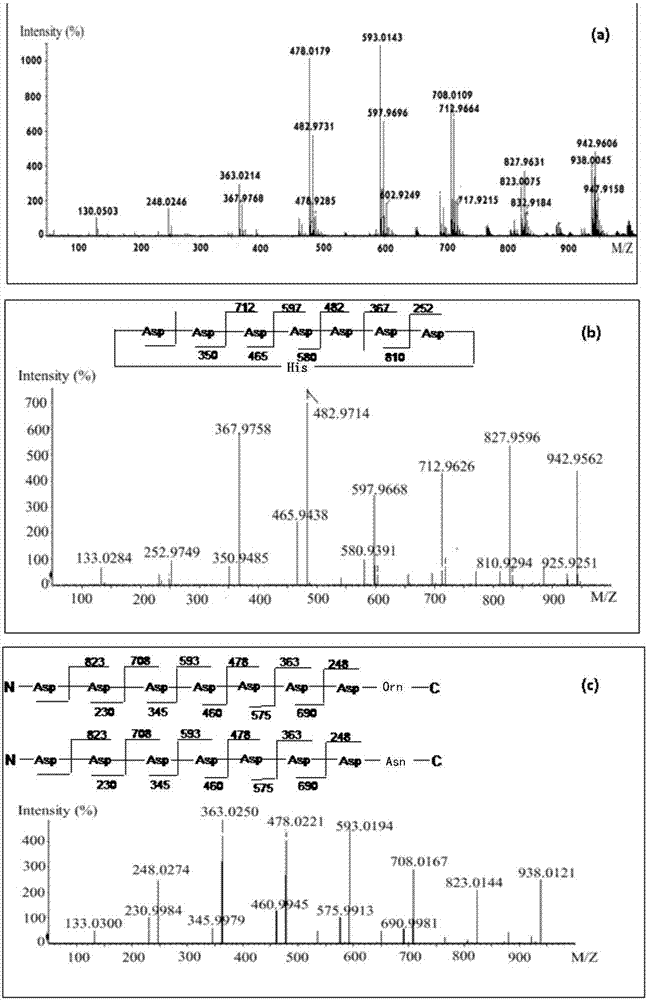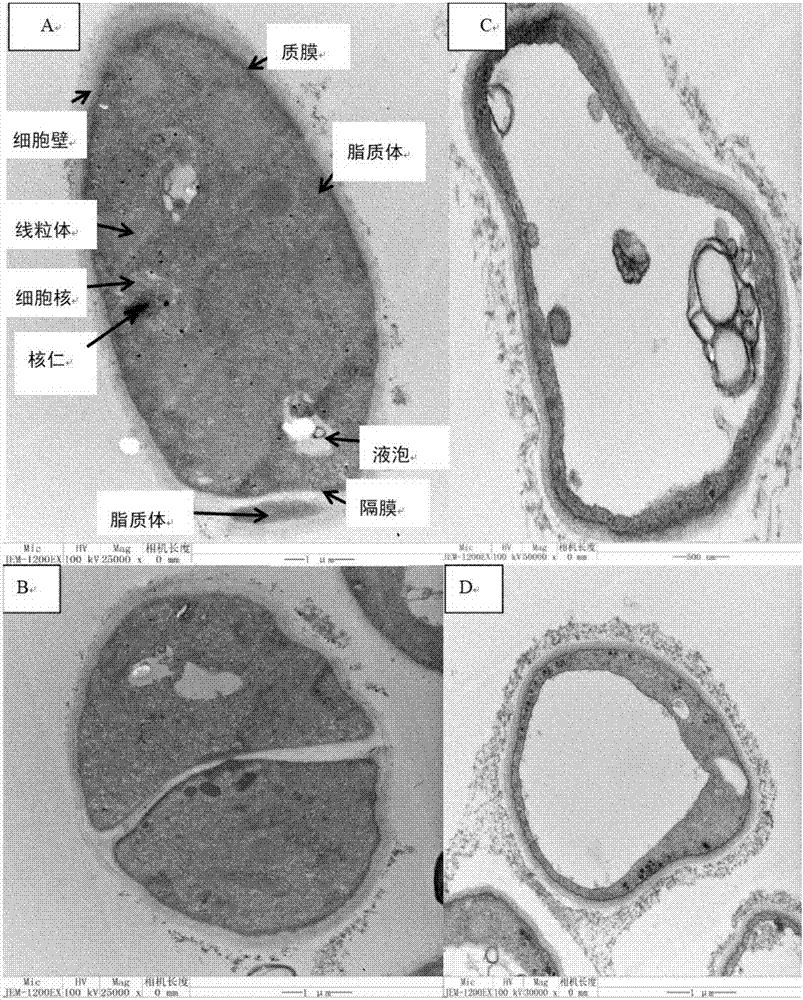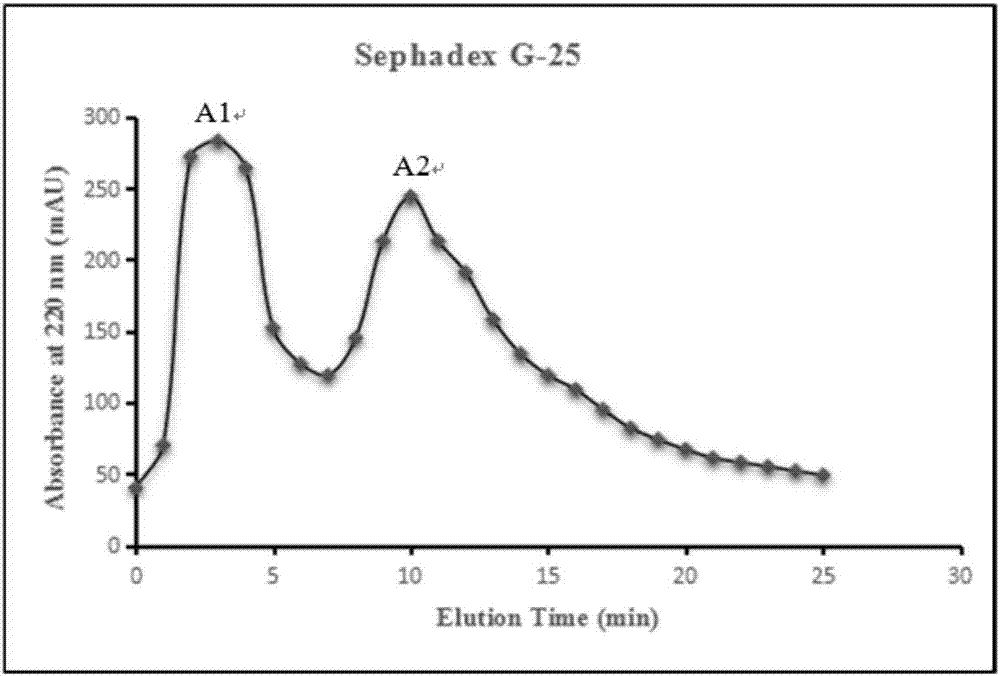Short peptide, application thereof and antibacterial composition obtained from short peptide
An antibacterial composition and short peptide technology, applied in the field of antibacterial compositions, can solve the problems of nutrient loss of raw materials, required equipment, material nutrient loss, etc., and achieve a good inhibitory effect.
- Summary
- Abstract
- Description
- Claims
- Application Information
AI Technical Summary
Problems solved by technology
Method used
Image
Examples
Embodiment 1
[0026] The embodiment of the present invention provides a kind of short peptide, this short peptide is first isolated from Bacillus megaterium fermentation liquid, specifically as follows:
[0027] Microorganisms used:
[0028] Aspergillus flavus A.flavus NRRL 3357: cultivated in PDA medium (200g potato extract, 20g glucose, 20g agar, 1L water).
[0029] Bacillus megaterium (CGMCC7086, preserved in the General Microorganism Center of China Microbiological Culture Collection Management Committee): cultured in beef extract peptone medium (beef extract 3g, peptone 10g, sodium chloride 5g, 1L water).
[0030] Purification and Identification:
[0031] 12 liters of Bacillus megaterium were cultured (160 rpm, 37°C, 3 days), and the fermentation broth was centrifuged at 8,000 r / min for 20 minutes. The centrifuged supernatant was precipitated with 80% ammonium sulfate, and after the precipitate was freeze-dried, it was chromatographed on Sephadex G-25 with a flow rate of 5 mL / min and...
Embodiment 2
[0050] Antibacterial test on solid medium
[0051] The 24 kinds of short peptides (all L-type) obtained above were subjected to the antibacterial effect test on Aspergillus flavus, respectively named as: a, b, c, d, e, f, g, h, i, j, k ,l,m,n,o,p,q,r,s,t,u,v,w,x, and compared with laboratory disinfectant-75% alcohol and strong fungicide-1% potassium permanganate Carry out the evaluation of antibacterial effect (repeat test 3 times). Among them, the specific test methods are:
[0052] Prepare solid PDA medium, pour the PDA medium into a 96-well plate to solidify; spread 4 microliters on the PDA medium for 10 6 Aspergillus flavus spores / ml, then take 10 microliters of various short peptides of 16 mg / ml, 75% alcohol, and 1% potassium permanganate and apply them to each sample well on a 96-well plate, and cultivate them at 28°C for 3 days. Days to observe the antibacterial results.
[0053] Such as Figure 4 As shown, the obtained 24 kinds of short peptides have a certain inh...
Embodiment 3
[0055] Bacteriostasis test in crop storage
[0056] The crops in this embodiment can be peanuts, corn, rice, cottonseed, nuts, etc., wherein, taking peanut storage as an example, the details are as follows:
[0057] First of all, it should be noted that since the 24 short peptides have been proved to have good antibacterial effects by Example 2, this example only takes Asp-Orn, Asp-Asn and Asp-Asn and Asp-Asn as examples for testing, and at the same time , in order to judge the impact of the configuration of each peptide on the antibacterial effect, the synthesis of different configurations was carried out by taking the above three peptides as examples. The resulting short peptides of different configurations were made into solutions of different concentrations, sprayed onto peanuts, and cultivated at 28°C for 7 days to observe the growth of Aspergillus flavus (as a control comparison: each peanut was inoculated with 10 5 aflatoxin spores).
[0058] Depend on Figure 5 It c...
PUM
 Login to View More
Login to View More Abstract
Description
Claims
Application Information
 Login to View More
Login to View More - R&D
- Intellectual Property
- Life Sciences
- Materials
- Tech Scout
- Unparalleled Data Quality
- Higher Quality Content
- 60% Fewer Hallucinations
Browse by: Latest US Patents, China's latest patents, Technical Efficacy Thesaurus, Application Domain, Technology Topic, Popular Technical Reports.
© 2025 PatSnap. All rights reserved.Legal|Privacy policy|Modern Slavery Act Transparency Statement|Sitemap|About US| Contact US: help@patsnap.com



